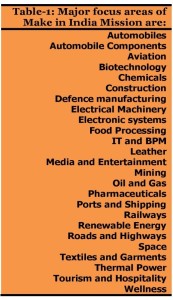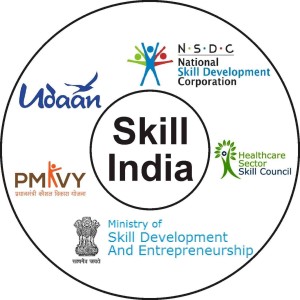Engineering Innovations! Engineering India!!
| Strategies for Conserving Indian Entrepreneurial Ecosystem |
India is well known for its youth power and recognized as one of the youngest nation worldwide. In order to  materialize the energy of over 67.6 crore youths, our Hon’ble prime minister comes up with Skill India, Make in India and Digital India initiatives. These initiatives would be the key pillars of Indian economy, if implemented strategically in reliance with major growing sectors of India and overseas. The primary objective of Make in India initiative is to transform India into a leading manufacturing hub. This will helps to create a more job opportunities in the multiple domains (Table-1) and simultaneously helps to generate more revenue for the country. A/c to BBC Sources (Sep 25, 2014) by the 2022, Government aimed to increase its share of manufacturing in the GDP upto 25% from current GDP of 15%. China is currently the world’s major manufacturing hub. China has received one third of its GDP from manufacturing. However, the positive side for Make in India initiative is the sudden increasing cost of manpower in China that demands new alternatives by the leading Investors. India in near future will be a potential alternative that allowed an economically viable ecosystem for leading investors and entrepreneurs.
materialize the energy of over 67.6 crore youths, our Hon’ble prime minister comes up with Skill India, Make in India and Digital India initiatives. These initiatives would be the key pillars of Indian economy, if implemented strategically in reliance with major growing sectors of India and overseas. The primary objective of Make in India initiative is to transform India into a leading manufacturing hub. This will helps to create a more job opportunities in the multiple domains (Table-1) and simultaneously helps to generate more revenue for the country. A/c to BBC Sources (Sep 25, 2014) by the 2022, Government aimed to increase its share of manufacturing in the GDP upto 25% from current GDP of 15%. China is currently the world’s major manufacturing hub. China has received one third of its GDP from manufacturing. However, the positive side for Make in India initiative is the sudden increasing cost of manpower in China that demands new alternatives by the leading Investors. India in near future will be a potential alternative that allowed an economically viable ecosystem for leading investors and entrepreneurs.
In order to promote this Initiative, GOI has promised to eliminate the unnecessary laws & regulations coupled with increased FDI, extended industrial licensing, simplified tax system, improved IPR stature, high-tech infrastructure facilities, online environmental clearance for industrial projects and time bound project clearance through a single online portal (eBiz-portal). Government has allowed 100% FDI in different sectors except few like Space (74%), Defence (49%) and News Media (26%). Invest India- an initiative by the Commerce ministry in order to accelerate the investment approvals for manufacturing will also complements the Make in India initiate.

In a preliminary effort, foreign companies will be invited in India to invest and set up new industries in various sectors. Major Investors that has shown their interest in Make in India initiative are Foxconn, Oppo, Huawei, Xiaomi, ZTE Corporation, Phicomm, Hitachi, Spice group, Lenovo, Wistron Corp (in Electronics); Mercedes Benz, BMW, Volvo, Renault, Boeing (in Automobiles); Hyundai Heavy Industries, Samsung, Sun Group, Reliance Infrastructure (in Defense), etc. A/c to Economic times sources (Nov 30, 2015), ‘Make in India’ initiative attracts proposals of worth Rs 1.2 lakh crores in Electronics manufacturing sector.
Undoubtly, Make in India projects India as a fertile industry base. India has a big labour pool and equipped with large domestic market for raw materials. However, there are few grey areas where we need to work out. At present scenario large number of chemical, electrical, mechanical, automobile and design engineers are underutilized in IT & Computer sectors. Make in India programme will be helpful to materialize the potential of such a huge army of engineers in their area of specializations and specific domains. Another concern that cannot be ignored is the backing off from setting up bases in India by leading giants like Vodafone, Walmart, etc. Time is to learn from neighbours like China and Japan. China has share of over 13% plus as against 1.4% of India in worldwide manufacturing. Japan has successfully stabilized its currency in an International market from past 20 years. Ideas are not enough; it’s a time to act on ground level. The key focus areas needs to be addressed with great emphasis are Reverse outsourcing, R&D in major technical streams, digital marketing, vocational trainings, advanced IPR Regimes, flexible policy measures, identification of priority sectors as start-ups (like Pharmaceutical and Biomedical engineering industries), etc. Need of the hour is to restructure the policy measures and infrastructure facilities in order to create an entrepreneur ecosystem that will harbour more and more national and internal investors.
Concerns over Government policies are not Indigenous, as reflected in the statement of a Nobel Laureate over Make in India Mission. A/c to a Prof. David Gross,
For a Successful Make in India mission and to build a sustainable global competitiveness, more focussed should be paid on the Discoveries and Inventions with prime focus on Basic Science and Research & Development that eventually translates into applied science and technologies and suggested to replace the slogan ‘Make In India’ with the slogan ‘Discover, Invent and Make in India’.
——–Prof. David Gross, Nobel Prize laureate for Physics, 2004.
Prof. Gross also shown his concern over Indian Scientific and Research apparatus related to funding and investment schemes. A/c per the Controller General of Patents, Designs and Trademarks (upto Dec 15, 2015) data and India spend report (Jan 11, 2016), out of 67342 patents awarded (2006-2015) by the IPO, only 15.76% accounted in the name of Indian Organizations/Institutes. In the List of Indian awardees, CSIR topped the list followed by BHEL. However, it is interesting to note that the Samsung India has got more patents in comparison to the Government organizations like DRDO and IITs. If we eliminate CSIR, BHEL, Samsung India, DRDO, IITs and SAI from the list, then only 5.07% of Indian Organizations/Institutes were made into a list. Not only has this, in another data only 5% patented researches of Indian Organizations got commercial acceptance. A/c to India Spend Report (Jan 12, 2016), around 98% of patents granted in 2015 were for applications more than five years old. Stringent IP system leads to patent delays could be the one reason for such reduced figures and necessized to create awareness about Research protection and IPR Rewards. Not only this, India is also lacking behind in Scientific Workforce. India has 4 Researchers per 10000 labours as against 18 and 79 in China and US, UK respectively (Nature Reports, May 2015). Such figures really put a big concern for the future of Innovations and Research & Development in our country and successful implement of the “Make in India” Mission with such a statistics seems to be quite difficult. As of Now, India spends 0.82 % of GDP for Research as against 2.01 % of China and 4.21% of Israel. Even a smaller country like Poland spends 0.87% of GDP for Research (World Bank). Experts recommend that India should increase their percentage share of GDP for Research so that more and more Government & Non-Government Organizations, Universities, Institutes come forward to Join hands for New Discoveries, Innovations and Research and Development in different sectors.
Make in India mission will be successful with skilled and trained manpower. In order to complement the Make in  India initiative, GOI has launched another initiative i.e. Skill India. Skill India initiative reflects believes of Indian Government towards 54% youth and aims to expose the vast inherent talent pool of the country. Skill India programme is an amalgamation of initiatives like National Policy for Skill Development and Entrepreneurship 2015, National Skill Development Mission, Pradhan Mantri Kaushal Vikas Yojana (PMKVY) and the Skill Loan scheme. Skill India mission aims to train over 40.02 crore people in different domains by 2022.
India initiative, GOI has launched another initiative i.e. Skill India. Skill India initiative reflects believes of Indian Government towards 54% youth and aims to expose the vast inherent talent pool of the country. Skill India programme is an amalgamation of initiatives like National Policy for Skill Development and Entrepreneurship 2015, National Skill Development Mission, Pradhan Mantri Kaushal Vikas Yojana (PMKVY) and the Skill Loan scheme. Skill India mission aims to train over 40.02 crore people in different domains by 2022.
Picture Courtsey: Prawny, www.clipartOf.com/48840.
Under this scheme existing skills of the persons can also be accessed and certified coupled with standardization of parameters for MES (Minimum Skills Set) in collaboration with Industries and private sectors. Steps towards cost effective training through optimum utilisation of existing infrastructure are also under consideration. Government also empathized on personalized training programme (delivered through various modes like part time, weekends, full time, onsite/ offsite, etc.) from foundation to advanced level in order to meet the Industrial demand.
As a preliminary marker step, GOI has reduced rate of Income Tax on royalty and fees from technical services i.e. from 25% to 10%. PMKVY aims to provide skill to 24 lakhs youth over the next one year who are lacking in vocational/formal/skill training or belongs to unorganised sectors. In a new phase PMKVY training covering 50,000 youth in 25 identified sectors. Through Skill India initiative, presently 249 training partners and 3222 training Centers associated and trained 55,70,476 individuals with 23,88,009 placements. Skill loan scheme, an another initiative of Skill India mission, loans ranging from Rs. 5,000-1.5 lakhs will be provided to 34 lakh youths willing to attend skill development programmes over the next five years. GOI allocated Rs 1500 crore in the budget for the Deen Dayal Upadhyay Grameen Kaushal Yojana, another initiative under Skill India mission in order to enhance the employability of Rural Youth. Government also proposed two IITs, two IIMs, three NIPER and two IISER.
In the continuity of Skill India initiative, our Government is going to launch another programme i.e. Start Up India on January 16, 2016 in order to catalyze the incentives derived from Skill India initiative in coming future.
Vision of the Government behind this initiative is to provide diverse opportunities to youths and be industrialists and entrepreneurs. Our Hon’ble Prime minister in one of his speech claimed for 1.25 lakh start ups, each giving employment to two-three peoples and notified that loans would also be given to help people in their startups. Government has launched an India Aspiration Fund for Start-Ups, an Initiative of the Small Industries Development Bank of India (SIDBI) in association with LIC of India as a Co-sponsor.
Under this venture Government has made few amendments in their policy measures and introduce a new form i.e. INC-29 in order to channelize a hassle free system for registration of Private limited company or Public limited company at no more time with minimum paper work. However, there are certain angles on which work out needs to be done like, easy loan access for Start Ups, help lines for assisting hassle free registration process of companies and Pvt. Limited’s, special Vocational trainings to initiate and volatilize business skills in beginners, more funding to those innovative Start Ups that has potential to create higher employment possibilities, etc. Apart from this, a demand for 1-3 years of tax and compliance holiday for start-ups is also rising by Biz-community.
A/c to a report “Higher Education in India: Vision 2030”, by FICCI and Ernst & Young, 75% of IT graduates are  deemed ‘unemployable’, 55% in manufacturing, 55% in healthcare and 50% in banking and insurance. Less than 5% of our potential workforce gets formal skill training to be employable and stay employable (Business Standards, Feb 28, 2015). Introduction of Industrial automation in lure of higher efficiency and efficacy can be a major competitor for skilled human empowerment in coming future and need to be addressed well ahead on time. For successful Skill India initiative areas of improvisation includes electronics, automobile, instrumentation, telecommunication, communication & IT, robotics & automation, chemical engineering etc. This could be possible by creating world-class academic institutions and skills training institutes, by providing more funding in elementary and vocational trainings, by creating more resources for applied research like biotechnology, nanotechnology, biomedical engineering etc. Time has come to reframed our polices so as to provide incentives that will attract the national and international leading companies to establish global innovation and manufacturing centres in India.
deemed ‘unemployable’, 55% in manufacturing, 55% in healthcare and 50% in banking and insurance. Less than 5% of our potential workforce gets formal skill training to be employable and stay employable (Business Standards, Feb 28, 2015). Introduction of Industrial automation in lure of higher efficiency and efficacy can be a major competitor for skilled human empowerment in coming future and need to be addressed well ahead on time. For successful Skill India initiative areas of improvisation includes electronics, automobile, instrumentation, telecommunication, communication & IT, robotics & automation, chemical engineering etc. This could be possible by creating world-class academic institutions and skills training institutes, by providing more funding in elementary and vocational trainings, by creating more resources for applied research like biotechnology, nanotechnology, biomedical engineering etc. Time has come to reframed our polices so as to provide incentives that will attract the national and international leading companies to establish global innovation and manufacturing centres in India.
Digital India is another initiative of our Hon’ble prime minister projected at Rs 1, 13, 000 crores. Major highlights of Digital India initiative are Digital Infrastructure, e-Governance and Digital Empowerment to the Citizens of India. Vision of Digital India initiative would be to provide broadband facilities in 2.5 lakh villages; universal phone connectivity; 400,000 Public Internet Access Points; Wi-Fi access in 2.5 lakh schools, and in all universities; high speed internet; Digital banking; Safe and secure Cyber-space; training and jobs in IT, Telecom and Electronics; eServices in health and education, etc. Digital lockers are one of the unique ventures of Digital India programme. Digital Lockers will facilitate storage of important documents like Passport, Marksheets, PAN Cards etc., digitally in an e-cloud space with sign up through Aadhaar card and Mobile numbers.
projected at Rs 1, 13, 000 crores. Major highlights of Digital India initiative are Digital Infrastructure, e-Governance and Digital Empowerment to the Citizens of India. Vision of Digital India initiative would be to provide broadband facilities in 2.5 lakh villages; universal phone connectivity; 400,000 Public Internet Access Points; Wi-Fi access in 2.5 lakh schools, and in all universities; high speed internet; Digital banking; Safe and secure Cyber-space; training and jobs in IT, Telecom and Electronics; eServices in health and education, etc. Digital lockers are one of the unique ventures of Digital India programme. Digital Lockers will facilitate storage of important documents like Passport, Marksheets, PAN Cards etc., digitally in an e-cloud space with sign up through Aadhaar card and Mobile numbers.
Picture Courtsey: Publichealthwatch, http://publichealthwatch.
WordPress.com/2013/10/11/mythbusters-affordable-care-act-edition/October 11, 2013.
Sweden presents distinguished example of digital literacy and becomes Worlds first cashless country. Presently there are handful of companies like TCS Ltd, WIPRO Ltd, INFOSYS, Samsung R&D Institute India-Bangalore Pvt. Ltd, Samsung India Software Operations Pvt. Ltd, etc that dominates IT World. GOI has also put their steps forward and in a new initiative, linked Digital India with Skill India. Efforts have been made to develop the Labour Market Information System (LMIS) in order to meet the demand and supply of skilled workforce in the country. Robotics and Automation added cost effectiveness and accuracy in the manufacturing system that could affect Make in India mission at somehow. Digital India Initiative can complement Make in India mission to overcome this. Digital India Initiative will strengthen Make in India and Skill India programmes globally through unique marketing strategies and accession policies. It’s a high for India to digitalize all the major existing and future programmes and initiatives in order to provide high-tech, time bound and single window facilities to the consumers.
By: Mr. Ajay Kumar ( Lecturer , Biotechnology Deptt. , Mewar Institute of Management, Ghaziabad)

